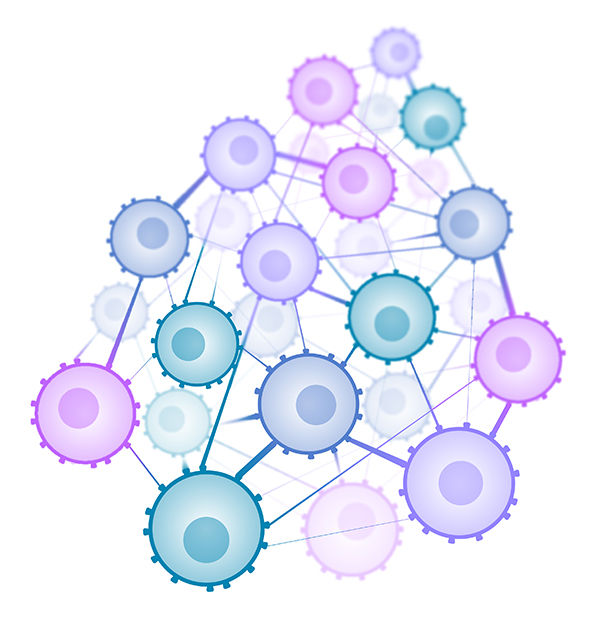Researchers unravel the social network of immune cells
“Macrophages are real chatterboxes”
Facebook, Instagram, Twitter – nowadays, good social networking and communication is more important than ever. The immune system also resembles a large social network, as shown by Felix Meissner and his team in the Experimental System Immunology Research Group at the Max Planck Institute of Biochemistry in Martinsried. With the help of proteomics they deciphered the messages exchanged between immune cells responsible for protecting us against diseases. In doing so, they have discovered complex cellular communication structures and previously unknown connections between various cell types.

Cells of the immune system need to communicate diligent with each other to defend successfully against diseases. Some cells send more informations than others, illustrated by differing line width.
M. Krause, © MPI of Biochemistry
Social networks such as Facebook now connect people around the globe, for the exchange of countless messages and pieces of information every day. Some people prefer to use social networks passively, only reading messages, while others have a strong need to communicate with others and tend to send out a large volume of information. The cells of our immune system work in a similar manner. When cells wish to communicate with each other, they emit messengers, unique signal molecules, which are detected by other cells via cell surface receptors. These messengers disseminate information throughout the body to control immune reactions against pathogens. Some cell types are more communicative than others. “Innate immune cells such as macrophages are real chatterboxes,” Meissner says.
Meissner and his colleagues searched for messengers and their receptors on cell surfaces using mass spectrometry-based proteomics. For their study, the scientists first sorted a total of 28 different immune cell types, including macrophages and lymphocytes, from the blood of healthy individuals by means of flow cytometry. Each cell type has a different function in the immune system and therefore, communicates differently. By sorting the cells, the researchers were able to study the unique communication behaviour of each cell type separately.
This large-scale analysis revealed the intricate communication networks between immune cells. “Every cell has a distinct character. We can determine who tells whom what story and also who is not listening,” Meissner reports. The researchers have identified previously unknown communication pathways between cell types. They also showed that the pattern of messengers and receptors on the surface of immune cells can change. “A fungal infection, for example, gives rise to a different network than, say, a bacterial infection,” Meissner explains.
In the future, the researchers want to investigate how cells communicate within tissues and how cellular communication behaviour changes during complex diseases.
Original publication
Most read news
Original publication
J.Rieckmann, R.Geiger, D.Hornburg, T.Wolf, Ksenya Kveler, D.Jarropssay, F.Sallusto, S.Shen-Orr, A.Lanzavecchia, M.Mann, & F.Meissner; "Social network architecture of human immune cells unveiled by quantitative proteomics"; Nature Immunology; März 2017
Topics
Organizations
Other news from the department science

Get the life science industry in your inbox
By submitting this form you agree that LUMITOS AG will send you the newsletter(s) selected above by email. Your data will not be passed on to third parties. Your data will be stored and processed in accordance with our data protection regulations. LUMITOS may contact you by email for the purpose of advertising or market and opinion surveys. You can revoke your consent at any time without giving reasons to LUMITOS AG, Ernst-Augustin-Str. 2, 12489 Berlin, Germany or by e-mail at revoke@lumitos.com with effect for the future. In addition, each email contains a link to unsubscribe from the corresponding newsletter.
Most read news
More news from our other portals
See the theme worlds for related content
Topic World Cell Analysis
Cell analyse advanced method allows us to explore and understand cells in their many facets. From single cell analysis to flow cytometry and imaging technology, cell analysis provides us with valuable insights into the structure, function and interaction of cells. Whether in medicine, biological research or pharmacology, cell analysis is revolutionizing our understanding of disease, development and treatment options.

Topic World Cell Analysis
Cell analyse advanced method allows us to explore and understand cells in their many facets. From single cell analysis to flow cytometry and imaging technology, cell analysis provides us with valuable insights into the structure, function and interaction of cells. Whether in medicine, biological research or pharmacology, cell analysis is revolutionizing our understanding of disease, development and treatment options.
Topic World Mass Spectrometry
Mass spectrometry enables us to detect and identify molecules and reveal their structure. Whether in chemistry, biochemistry or forensics - mass spectrometry opens up unexpected insights into the composition of our world. Immerse yourself in the fascinating world of mass spectrometry!

Topic World Mass Spectrometry
Mass spectrometry enables us to detect and identify molecules and reveal their structure. Whether in chemistry, biochemistry or forensics - mass spectrometry opens up unexpected insights into the composition of our world. Immerse yourself in the fascinating world of mass spectrometry!


















































